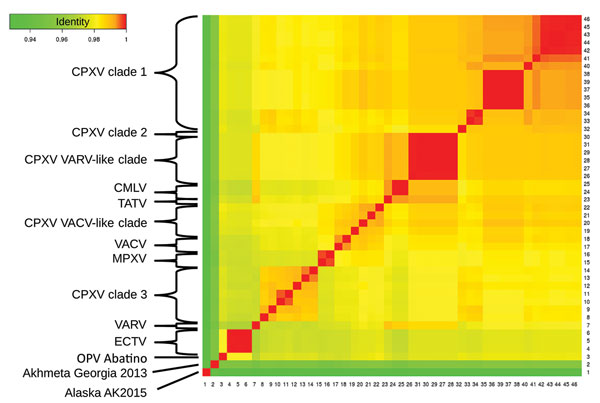Volume 23, Number 12—December 2017
Synopsis
Fatal Outbreak in Tonkean Macaques Caused by Possibly Novel Orthopoxvirus, Italy, January 20151
Figure 5

Figure 5. Identity between OPV Abatino, obtained from skin lesion of Tonkean macaque during outbreak at animal sanctuary, Italy, January 2015, and available OPV genomes on the basis of 9 concatenated conserved genes: A7L, A10L, A24R, D1R, D5R, H4L, E6R, E9L, and J6R. Red indicates more similarity, green less similarity. Sequences shown (GenBank accession nos.): 1) OPV Tena Dona AK2015 (KX914668–76); 2) OPV GCP2013 Akhmeta (KM046934–42); 4–6) ECTV-Moscow (AF012825.2), ECTV-Naval (KJ563295.1), ECTV-VR-1431 (JQ410350.1); 7) VARV-Bangladesh-1975 (L22579.1); 8–14) CPXV-HumLue09–1 (KC813494.1), CPXV-Germany1990–2 (HQ420896.1), CPXV-Francy2001-Nancy (HQ420894.1), CPXV-MarLei07–1 (KC813499.1), CPXV-Norway1994-MAN (HQ420899.1), CPXV-UK2000-K2984 (HQ420900.1), CPXV-BrightonRed (AF482758.2); 15–16) MPXV-Congo2003–358 (DQ011154.1), MPXV-Liberia-1970–184 (DQ011156.1); 17–18) VACV-IOC-B141 (KT184690.1), VACV-Lister (KX061501.1); 19–22) CPXV-Austria1999 (HQ407377.1), CPXV-HumLit08–1 (KC813493.1), CPXV-GRI90 (X94355.2), CPXV-Finland2000 (HQ420893.1); 23) TATV-Dahomey-1968 (DQ437594.1); 24–25) CMLV-0408151v (KP768318.1), CMLV-M96 (AF438165.1); 26‒31) CPXV-HumGra07–1 (KC813510.1), CPXV-RatKre08–2 (KC813505.1), CPXV-RatGer09–1 (KC813503.1), CPXV-RatAac09–1 (KC813501.1), CPXV-HumAac09–1 (KC813508.1), CPXV-HumKre08–1 (KC813512.1); 32) CPXV-Germany1998–2 (HQ420897.1); and 33–46) CPXV-Germany1980-EP4 (HQ420895.1), CPXV-HumPad07–1 (KC813496.1), CPXV-HumLan08–1 (KC813492.1), CPXV-RatHei09–1 (KC813504.1), CPXV-MonKre08–4 (KC813500.1), CPXV-JagKre08–1 (KC813497.1), CPXV-JagKre08–2 (KC813498.1), CPXV-Germany2002-MKY (HQ420898.1), CPXV-HumGri07–1 (KC813511.1), CPXV-HumMag07–1 (KC813495.1), CPXV-CatBer07–1 (KC813502.1), CPXV-HumBer07–1 (KC813509.1), CPXV-CatPox07–1 (KC813506.1), CPXV-BeaBer04–1 (KC813491.1). CMLV, camelpox virus; CPXV, cowpox virus; ECTV, ectromelia virus; MPXV, monkeypox virus; OPV, orthopoxvirus; TATV, taterapox virus; VACV, vaccinia virus; VARV, variola virus.
1Preliminary results from this study were presented at the Xth International Congress of the European Society for Veterinary Virology; August 31–September 3, 2015; Montpellier, France.
2These first authors were co–principal investigators who contributed equally to this article.